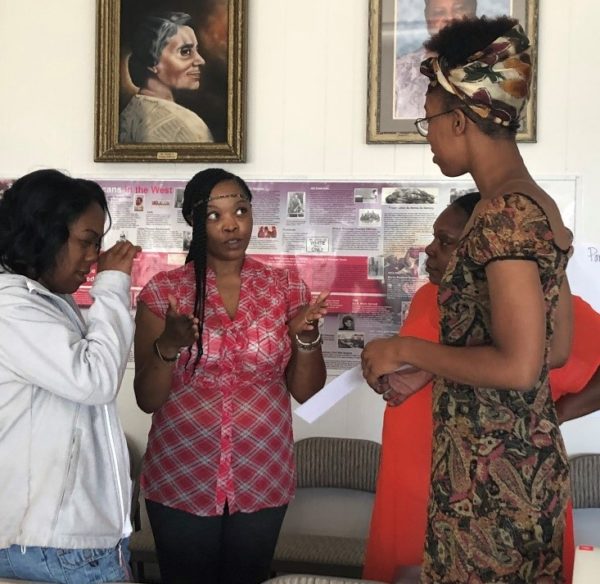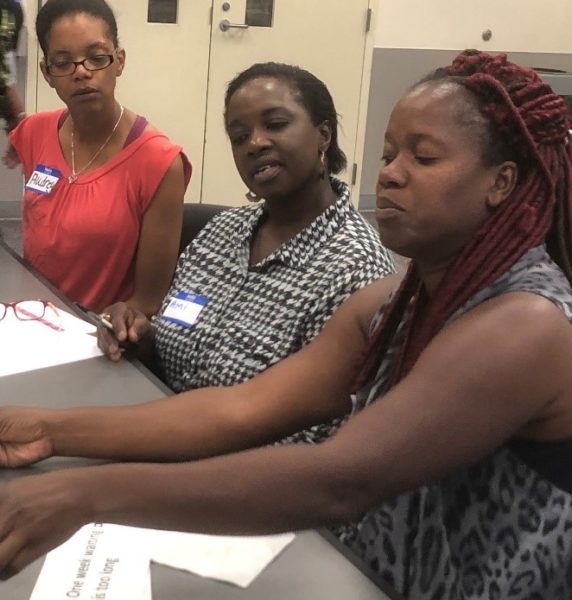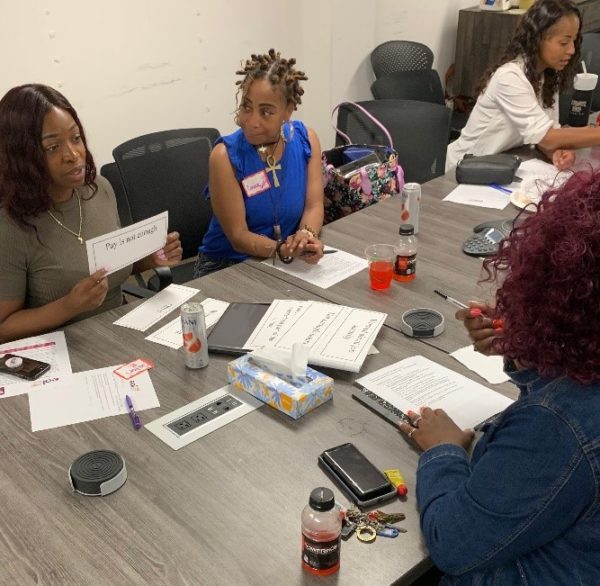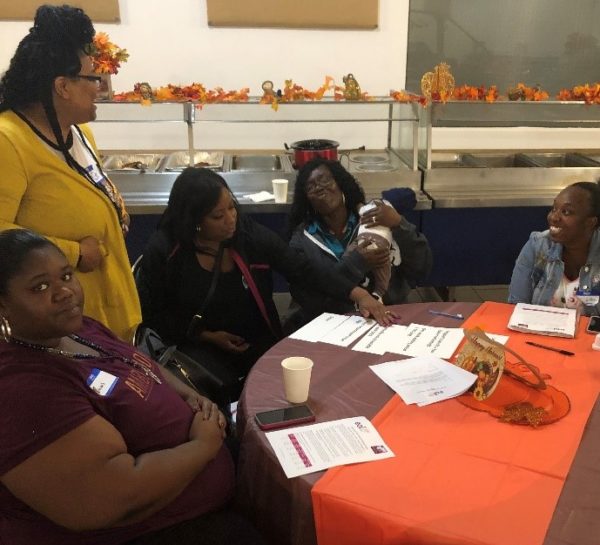For a PDF, click here.
Introduction
In January 2020, Washington will become the fifth state in the U.S. to provide a comprehensive paid family and medical leave program (PFML). Workers will be able to take up to 12 weeks, and in some cases up to 18 weeks, of paid leave in a year to care for a new child, seriously ill family member, their own serious health condition, or cope with a family member’s military deployment. Washington’s Employment Security Department administers the program, which is funded by payroll contributions of employees and employers.
PFML has the potential to boost health and economic security for all families and to greatly reduce health and other disparities by race, gender, and income. These positive impacts could be especially beneficial for African-American and other communities of color. African-American and Native American women experience much higher rates of pregnancy-related health complications and maternal mortality than women of most other racial groups, and their children have higher rates of preterm birth and infant mortality. Black women and children also are more likely to live in or near poverty than their White counterparts.
However, PFML alone is unlikely to completely eliminate race-related differences in outcomes. Lower incomes and lack of assets among Black Americans compared to other racial groups are rooted in a long history of structural and institutional racism, including in access to employment and workplace opportunities. Moreover, adverse health effects are not based solely on socioeconomic factors. The daily experience of discrimination and structural racism – including receiving poorer quality health care – and associated Post-Traumatic Stress Disorder, likely also contribute.[1]
During the summer and fall of 2019, the Economic Opportunity Institute partnered with community organizations to conduct four listening sessions with African-American women to identify awareness of and attitudes toward paid family and medical leave and possible barriers to taking leave. The listening sessions revealed general excitement about the program and eagerness to learn more. All of the participants viewed PFML as a needed benefit that would help their families and communities.
Many of the participants also expressed apprehension about taking a full 12 or more weeks of leave because of cultural attitudes and prejudice in the workplace against Black workers. The lack of job protection guarantees for workers in companies with fewer than 50 employees compounded this fear. For a number of participants, the amount of time they might have to wait between an initial application and receiving benefit payments was also a factor in whether they could use the program at all.
Equity Goals of Program and Potential Barriers to Equitable Access
Policy Design
Washington’s legislature adopted the program in 2017, based on a policy negotiated by a table of stakeholders and bipartisan group of legislators. The policy incorporates a number of design elements intended to make the program equitably accessible across income, race, and type of employment. These include:
- Providing progressive benefits, with lower-wage workers receiving 90% wage replacement and middle-income workers 67% to 75% wage replacement;
- Ensuring portability between employers and during periods between jobs;
- Including multiple employers and contract work in establishing eligibility and typical wages;
- Including a broad range of family members, including grandparents, grandchildren, siblings, and parents-in-law; and
- Requiring ESD to conduct outreach about the program.
However, the negotiated policy also includes factors that may undercut equitable access, including:
- A lack of job protection for people not already covered by the federal Family and Medical Leave Act (FMLA), meaning that people who work for employers with fewer than 50 employees, who have been on the job less than a full year, or who worked less than 1,250 hours the previous year will not be guaranteed their jobs back after PFML leaves;
- An 820-hour work requirement in the previous year (across any combination of employers, including self-employment); and
- A one-week waiting period for leaves other than for bonding.
Administrative Challenges
As the implementation date approaches and the initial application process that will be in place in January 2020 has crystalized, additional potential barriers are becoming evident. While ESD has a dedicated staff committed to continuous improvement, changing or adding features to the application portal and speeding up the application process will take time. There is also a high degree of uncertainty with a new program with no track record. During the early months of the program, a number of factors will make access for lower income workers, communities of color, immigrants, and rural communities more challenging.
The application process itself will be daunting for many people, especially considering that many will be applying during times of particular stress.
- Initially, people will be able to apply either online or by requesting a paper application. No phone or in-person application process will be available, although these might be added at some later date.
- Application materials will only be available in English, although the program website has a Spanish-language page with materials and explanations.
- Workers will have to go through a 4-stage process to apply:
- Informing their employer of their intent to take leave and gathering medical certification and other required documentation;
- Creating an account (or phoning in to request a paper application);
- Submitting an initial application for leave, including submitting required documentation, and receiving approval from ESD; then
- Submitting weekly applications for benefits once their leave is approved.
The length of time that it will take for people to have leaves approved and to receive their first benefit payment will be particularly problematic for people with fewer resources to fall back on or who feel more vulnerable to discrimination or retaliation in the workplace.
- During the first month, ESD anticipates that it may take between 15 and 30 days for initial applications to be processed and approved. While the department has committed to getting approval times down to no more than one week, it is unlikely that they will hit that goal until after several months.
- Once an initial application is approved, workers will receive weekly payments either through direct deposit or automatic loading of a pre-paid card. This process mirrors the established practice for unemployment insurance payments and should happen within a few days of the worker filing each weekly benefit application.
As a launch of both a new program and new technology, there are particular problems. Start-up glitches are also likely.
- The technology for the application process will not be available for workers to create their account and file the initial application for approval of leave prior to January. In fact, because January 1 is a holiday for state employees, ESD plans to not open the application site to the public until January 2, so that full staffing and technology support are available to troubleshoot any problems that arise.
- A new program means that more people are likely to call with questions than will be the case once the program is well established. Employers, workers, medical professionals, social workers, and other informants are all learning at the same time. Agency staff also face a learning curve and will take a little longer to review applications and resolve issues during the first few weeks.
- No one knows how many people are going to try to apply during the first week. Over time, applications should smooth out, but there is likely to be an initial rush. Parental leave benefits can be taken any time during the first 12 months following a child’s birth or placement, so parents whose child joined the family during 2019 may well apply right away. In addition, people may have delayed surgeries and other non-emergency medical or family leaves until the program becomes available.
The Listening Sessions
EOI partnered with four community-based organizations to host and recruit participants for listening sessions with African-American women. EOI provided each organization a financial grant to cover their staff time and other costs. Participants in the listening sessions received $50 and a meal. Childcare was also provided.

Participants in Numbers to Names Listening Session
Participants were given information about the PFML program and responded to a series of questions about their employment and family situations, previous experiences with needing extended leaves, how valuable they thought the PFML program would be, and concerns or potential barriers they perceived with using the program.
Altogether, 38 women participated, ranging in age from early 20s to late 60s, including low-income single moms, women with other family care needs and their own health challenges, formerly incarcerated women, military veterans, service sector and professional workers. All but a handful of participants identified as African-American.
Overall, listening session participants were enthusiastic about the PFML program and saw it as highly beneficial. Most had not realized that they were already contributing to the program. Many were concerned about the lack of job protection.
As Black women, many felt that their employers and coworkers were more likely to suspect them of being “lazy” and to retaliate against them if they took the full length of leave they might need. These fears were compounded for formerly incarcerated women, who felt they had an additional strike against them.
Some with service sector jobs also worried about the 820-hour work requirement to qualify, and several expressed it would be important to receive their benefits promptly because they had no income cushion.
Listening Session Organizational Partners
| Organization and Mission | Location | Participants | Date |
| Urban League of Metropolitan Seattle – empowers African Americans and underserved communities to thrive by securing educational and economic opportunities | Seattle Central District | 6 | July 16, 2019 |
| Numbers to Names – dedicated to building bridges between communities and people who have been incarcerated or impacted by incarceration | Tacoma | 9 | July 20, 2019 |
| Vets Place NW –provides mental health and other support services for veterans and their families | Marysville | 7 | August 20, 2019 |
| Tiny Tots Development Center – provides child care and early childhood education in a nurturing environment | Southeast Seattle | 16 |
September 17, 2019 |
Previous experiences with taking leave
Many of the women had had experience taking leaves for a new child, serious health condition, or caring for a seriously ill family member. Some had taken leave under the federal FMLA, and experienced a great deal of financial stress because the leave was unpaid. One woman described having taken unpaid FMLA after both of her daughters were born by C-section and the financial strain that resulted. Others had cobbled together sick leave, PTO, unpaid leave, and in a few cases, donated leave from coworkers to cover these leaves.

Participants in Vets Place NW Listening Session
Many had returned to work sooner than they wanted to from previous leaves because they needed the pay or feared losing their jobs, and several reported being fired. One woman said she wanted to take three months of maternity leave, but returned to work after four weeks when her saved-up sick leave and vacation ran out. Another who worked at a nonprofit in Federal Way reported that her employer forced her to work from home while she recovered from surgery, but still fired her because her “numbers were down.” A woman who worked in a small office with only three employees said her employer hired a temp when she took leave, then refused to take her back afterwards.
Attitudes of employers toward worker health and care-giving needs varied considerably. Some said their employers were supportive of time to heal and be with family. One woman described being encouraged to take time off and supportive colleagues when her son died. Another who had had a union, public sector job had been able to take a full six months of maternity leave, then work part-time during her first four months back at work. Another reported that when she needed emergency surgery, 20 coworkers donated leave to her, but she still felt stressed and feared being fired once her FMLA protections ran out, so returned to work.
The reason for leave could also make a difference in employers’ attitudes. One woman had had two different experiences with the same employer. When she was pregnant and hospitalized to prevent a premature delivery, her employer readily accepted her need for the leave. But when her doctor said she needed three weeks off work due to stress, her employer was less willing to grant the time.
Women in every listening session raised the additional challenges they faced as Black women in the workplace. They often felt stigmatized as lazy by supervisors and coworkers. Any assertiveness on their part could be interpreted as angriness. One woman commented: “What Black women face – the retaliation is high. It can be different kind of treatment than for others.”
Many women commented on the stress and time crunch of being a working mom. Several noted that their employers only claimed to support work-life balance, while making it difficult for employees to take time off for family needs. Some company policies required “jumping through hoops,” and some employers failed to inform employees about FMLA rights.
In some cases, the attitudes of individual supervisors or co-workers could also be a problem. A woman who had to take her mother to a series of appointments felt her coworkers thinking, “Oh, she’s out again.” Another woman who had had a sick child commented:
“I know I had to work, make rent, put food on the table, deal with my sanity, and deal with a manager who looked at me with side-eye about – oh you’re going to go run off and deal with your ‘sick son’.”
Another woman said:
“Some people, it’s unbelievable what the job does to them. Work tries to squeeze you, won’t let people take time off even if their doctor tells them to. But if you reinjure yourself, you’ll just have to stay out longer.”
Responses to Washington’s Paid Family & Medical Leave Program

Participants at Urban League Listening Session
The listening session participants were enthusiastic about the PFML program and eager to learn more – with some reservations about how the program would work in practice. Among the immediate responses were: “It’s a huge win, especially for people who don’t have any kind of benefit.” “How do I apply?” and “Where was this 10 years ago?”
Many had heard something about the program, often through a notice from their employer when payroll premium collection began. However, few had specific information or awareness of the premiums being deducted from their paychecks. Some were also confused about how PFML differed from the federal FMLA.
Specific benefits of the program that participants cited included:
- Not having to save up all their sick leave and vacation to try to cover maternity and other longer leaves;
- The ability to care for aging parents;
- Not having to postpone surgeries because of lack of paid leave;
- Preventing burn out from having to balance job and family or health needs; and
- The progressive benefit structure, making it more accessible to lower-wage workers.
Concerns and Barriers to Program Use
For many of the women, there was a sense that the PFML program was too good to be true – there must be a catch. The most consistently noted concerns and barriers to use were:

Participants in Tiny Tots Listening Session
Lack of job protection: Most were concerned about the lack of job protection for workers in smaller companies, particularly for lower wage workers and those who had faced incarceration in the past or faced other barriers to finding a new job. Comments included: “The employer can say, ‘you can leave and you can stay gone.’” “It’s dependent on the employer once again.” “Formerly incarcerated will not want to shake anything up or ruffle any feathers for the benefit.” “People will be so afraid to lose their job… and have to deal with the challenges of finding another job.”
Discrimination and retaliation: Many felt as Black women they would face more suspicion about whether they really needed the leave and possible retaliation for using the program: “The treatment you will get when you get back will be way different than white women.” “There’s a stigma. People ask, is she really sick.” Women who had been formerly incarcerated felt a double stigma.
Possible delay getting benefits: The participants often asked how quickly and how frequently they could count on benefits. Any delay was a big concern. Most depended on every pay check to cover basics of rent, food, and providing for their children.
Week waiting period: The week waiting period for leaves other than parental leave was confusing and concerning.
820 hour work requirement: Some also noted that the 820 hours of work required to qualify might be too much, especially for people working in retail or fast food.
Cultural attitudes: Lack of cultural acceptance among Americans for taking leave in general was also a factor: “America just has cultural thing making taking time off not acceptable.” “We feel like we have to get this work done. If we take too long off, we just come back to a big mess.” The potential burden taking a long leave would place on their co-workers was also a concern for some.
Getting the word out: Few of the participants had much knowledge about the program prior to the listening session. People need to know about the program and receive clear information about it. Employers and social media were seen as key, along with word of mouth.
Recommendations and Next Steps
The policy parameters for the PFML program for 2020 are already set. Changes to policies to address equitable access will have to wait until later legislative sessions as we start to see outcomes and results from the program. However, changes to application and administrative procedures and in public communications can be made throughout 2020.
To smooth and speed up the application process, it will be essential to provide clear information to employers, employees, health care providers, and other community informants through a variety of channels. ESD and community partners are already working on outreach and communication materials, and all will need to continue to prioritize outreach and be prepared to adjust messages and methods of communication as areas of confusion and gaps in coverage are identified.
The application process itself and the length of time people have to wait for benefits may present especial challenges to lower-income communities, immigrant workers, and people in more rural areas or with otherwise limited access to internet connections and services. Over the first months of the program, it will be important to monitor and develop strategies to correct or improve:
- Any difficulties particular groups or communities are having with accessing and submitting applications for benefits;
- The time it takes from initial application to receipt of benefits;
- Reasons why applications are being rejected and the types of supporting documents people are having trouble acquiring; and
- Call-line wait times.
Ways to mitigate potential barriers in the application process include:
- Broadly distributing clear “before you apply” and “how to apply” pieces;
- Providing paper applications and resources in multiple languages, along with staff trained to answer basic questions at WorkSource centers around the state, which are also administered by ESD;
- Ensuring that staff from other state agencies are well informed about the program and can help people also apply for PFML as appropriate when they qualify for WIC, Medicaid, or other forms of state assistance; welcome a foster child into the family; or have elder care needs;
- Working with a broad range of community groups and service providers to inform people about the program and help them navigate the process; and
- Rapidly incorporating design improvements into the technology.
EOI will be collecting information from workers, coalition partners, and informants on the ground throughout 2020, including from the organizations that co-hosted listening sessions in 2019. We will hold additional listening sessions in the spring and summer of 2020 to get more detailed feedback from people who used the program or needed leave yet did not use PFML. Looking further ahead, we will monitor program use statistics and other state data that may indicate whether equity goals for access and outcomes are being achieved. This input will help inform priorities for possible policy changes to the program going forward.
Acknowledgements
EOI gratefully acknowledges the contributions to this report by:
- the 38 women who participated in the listening sessions;
- the staff and volunteers who helped organize and coordinate the sessions from the Urban League of Metropolitan Seattle, Numbers to Names, Vets Place NW, and Tiny Tots Development Center;
- The anonymous donor who funded this research.
Footnote
[1] Jamila Taylor, et al, “Eliminating Racial Disparities in Maternal and Infant Mortality: A Comprehensive Policy Blueprint,” May 2019, Center for American Progress, https://www.americanprogress.org/issues/women/reports/2019/05/02/469186/eliminating-racial-disparities-maternal-infant-mortality/; Kim Eckart, “How discrimination, PTSD may lead to high rates of preterm birth among African-American women, March 21, 2019, UW News, http://www.washington.edu/news/2019/03/21/how-discrimination-ptsd-may-lead-to-high-rates-of-preterm-birth-among-african-american-women/.
More To Read
June 5, 2024
How Washington’s Paid Leave Benefits Queer and BIPOC Families
Under PFML, Chosen Family is Family
November 21, 2023
Why I’m grateful for Washington’s expanded Paid Family & Medical Leave
This one is personal.
February 10, 2023
Thirty Years of FMLA, How Many More Till We Pass Paid Leave for All?
The U.S. is overdue for a federal paid leave policy
